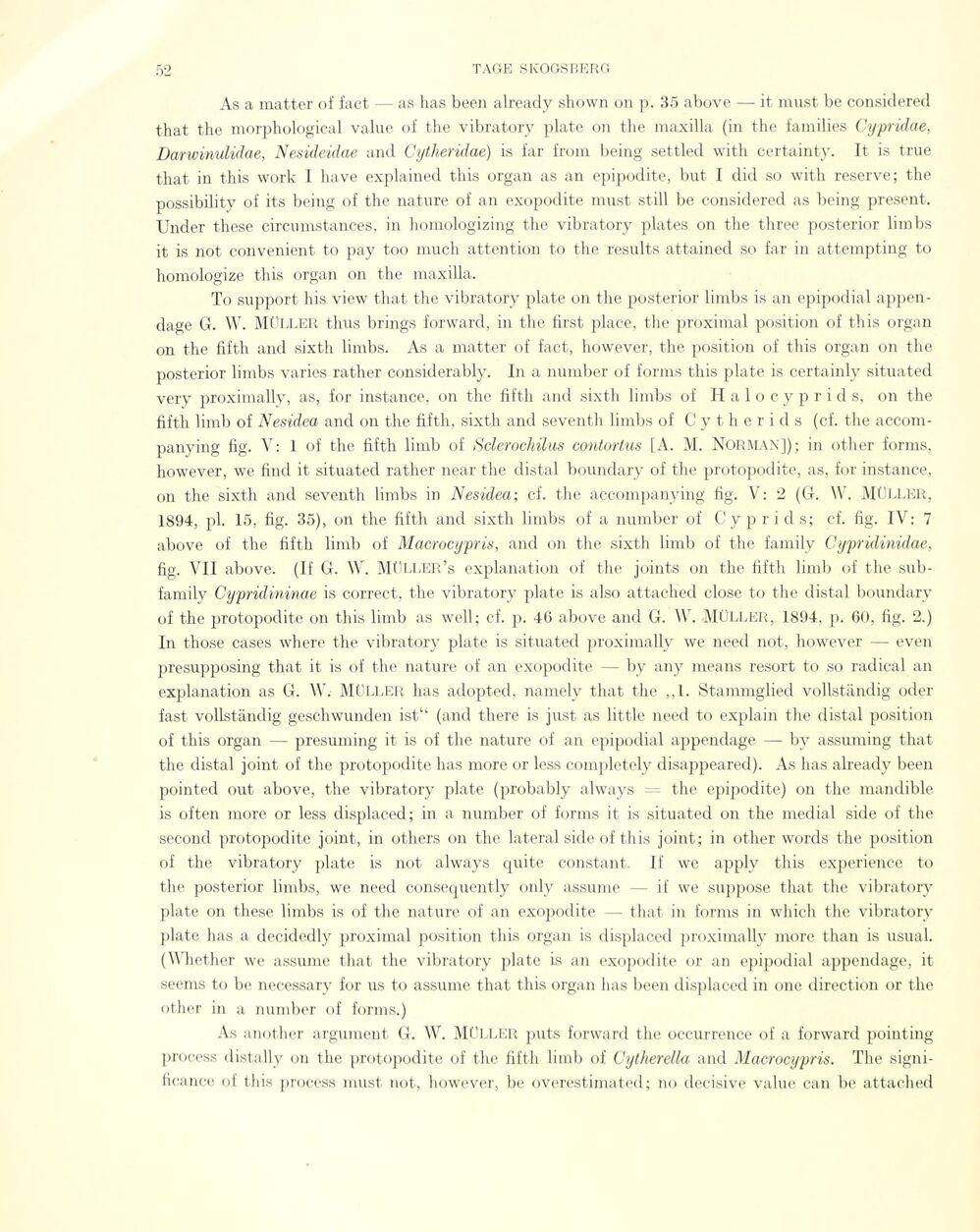
Full resolution (JPEG) - On this page / på denna sida - Sidor ...

<< prev. page << föreg. sida << >> nästa sida >> next page >>
Below is the raw OCR text
from the above scanned image.
Do you see an error? Proofread the page now!
Här nedan syns maskintolkade texten från faksimilbilden ovan.
Ser du något fel? Korrekturläs sidan nu!
This page has never been proofread. / Denna sida har aldrig korrekturlästs.
As a matter of faet — as has been already shown on p. 35 above — it must be considered
that the morphologica! value of the vibratory plate on the maxilla (in the families Cypridae,
Darwinididae, Nesideidae and Cytlieridae) is far from being settled with certainty. It is true
that in this work I have explained this organ as an epipodite, but I did so with reserve; the
possibility of its being of the nature of an exopodite must still be considered as being present.
Under these circuinstances, in bomologizing the vibratory plates on the three posterior limbs
it is not convenient to pay too mueh attention to the results attained so far in attempting to
homologize this organ on the maxilla.
To support his view that the vibratory plate on the posterior limbs is an epipodial
appen-dage G. W. Müller thus brings forward, in the first place, the proximal position of this organ
on the fifth and sixth limbs. As a matter of faet, however, the position of this organ on the
posterior limbs varies rather considerably. In a number of forms this plate is certainly situated
very proximally, as, for instance, on the fifth and sixth limbs of H a 1 o c y p r i d s, on the
fifth limb of Nesidea and on the fifth, sixth and seventh limbs of Cytherids (cf. the
accom-panying fig. Y: 1 of the fifth limb of Sderochilus contortus [A. M. NORMAN]); in other forms,
however, we find it situated rather near the distal boundary of the protopodite, as, for instance,
on the sixth and seventh limbs in Nesidea; cf. the accompanying fig. V: 2 (G. W. MÜLLER,
1894, pi. 15, fig. 35), on the fifth and sixth limbs of a number of Cyprids; cf. fig. IV: 7
above of the fifth limb of Macrocypris, and on the sixth limb of the family Gypridinidae,
fig. YII above. (If G. W. MÜLLER’s explanation of the joints on the fifth limb of the
sub-family Cypridininae is correct, the vibratory plate is also attached close to the distal boundary
of the protopodite on this limb as well; cf. p. 46 above and G. W. MÜLLER, 1894, p. 60, fig. 2.)
In those cases where the vibratory plate is situated proximally we need not, however — even
presupposing that it is of the nature of an exopodite — by any means resort to so radical an
explanation as G. W. MÜLLER has adopted, namely that the ,,1. Stammglied vollständig oder
fast vollständig geschwunden ist“ (and there is just as little need to explain the distal position
of this organ — presuming it is of the nature of an epipodial appendage — by assuming that
the distal joint of the protopodite has more or less completely disappeared). As lias already been
pointed out above, the vibratory plate (probably always = the epipodite) on the mandible
is often more or less displaced; in a number of forms it is situated on the medial side of the
second protopodite joint, in others on the lateral side of this joint; in other words the position
of the vibratory plate is not always quite constant. If we apply this expérience to
the posterior limbs, we need consequently only assume — if we suppose that the vibratory
plate on these limbs is of the nature of an exopodite — that in forms in which the vibratory
plate lias a decidedly proximal position this organ is displaced proximally more than is usual.
(Whether we assume that the vibratory plate is an exopodite or an epipodial appendage, it
seems to be necessary for us to assume that this organ has been displaced in one direction or the
other in a number of forms.)
As another argument G. W. Müller puts forward the occurrence of a forward pointing
process distally on the protopodite of the fifth limb of Cytherella and Macrocypris. The
signi-ficance of this process must not, however, be overestimated; no decisive value can be attached
<< prev. page << föreg. sida << >> nästa sida >> next page >>